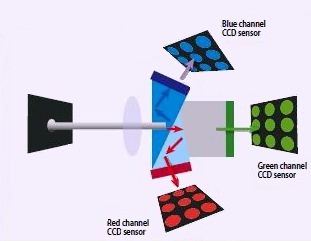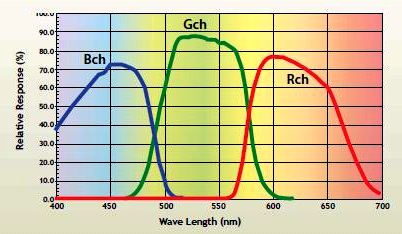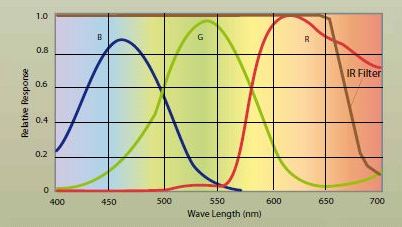|
||||||||||||||||||||||||||||||||||||||||||
|
||||||||||||||||||||||||||||||||||||||||||
The 3CCD colour advantage: Let the benefits speak for themselves
Do you need high-precision colour, enhanced resolution and less noise?
All sensors, whether single/multiple CCD or CMOS types, read physical data (light) and translate them into digital information (pixel data).
 So
what makes a multi-sensor array better at capturing and translating
colour than a single sensor imager? So
what makes a multi-sensor array better at capturing and translating
colour than a single sensor imager?How does a 3-CCD sensor work? 3-CCD (sometimes called "three-chip") cameras employ, as the name suggests, three sensors, each one capturing a separate image of red, green or blue light. Light after being transmitted through the lens passes through a dichroic prism assembly (see illustration on right) which splits light into 3 paths, and each path is filtered into one of the 3 component colours and then transmitted onto the sensor. The sensors are accruately positioned and aligned so that a ray of light passing therough the lens and prism hits the same corresponding pixel on each of the 3 sensors.Therefore every pixel in the image measures each of the 3 colours truly. This separate capturing of colour channels means that the camera has more colour information and control over the individual red, green and blue planes. It produces a truer, deeper colour image with better precision than a single-CCD. By comparison, single-CCD cameras use a Bayer filter which can only have a single colour filter on each pixel. They capture only 1/3rd of the incoming colour information and so must reconstruct the remaining 2/3rds by estimation using interpolation, a value for the "missing" information. For example a pixel with a green filter only measures green. The create a red value for this pixel the camera uses surrounding pixels with a red filter and so extimates a red value for the green pixel. The same is done for its ble colour. This interpolation of data results in a lower effective resolution. Benefits of multi-sensor CCD technology for colour imaging Superior colour quality without interpolation Compared to cameras with a single CCD, three-CCD cameras generally provide superior image quality through enhanced resolution and lower noise. By taking advantage of the separate values for red, green and blue values for each pixel, multi-sensor cameras achieve much better accuracy in the colour output than do their single-CCD counterparts. |
||
| Special prism coating increases
edge accuracy The spectral curves resulting from the hard dichroic prism coatings are much steeper than the curves from the soft polymer dyes used in single-CCD sensors. This enables the 3-CCD cameras to produce exceptionally accurate colour data without the uncertainty that comes from the overlap regions. (See diagrams on left) Acute sensor alignment gives greater precision New 3-CCD cameras feature precise sensor alignment of less than 1/4 -pixel tolerance (roughly 1 µm accuracy), to provide better spatial precision than single-CCD cameras whose Bayer filters result in uncertain outputs for edge positions. |
 |
 |
Steep
spectral curves from a 3-CCD prism camera |
Typical
spectral overlap from 1-CCD Bayer mosaic filter |
|
| High Dynamic range In a single-CCD colour sensor camera, in addition to reducing colour precision, the overlap in the colour filter response also results in part of each pixel’s well capacity filling with photons from the wrong colour (cross talk), and so decreasing the available well capacity. With multi-sensor CCD cameras less colour overlap from the dichroic coatings enable each channel to use the full well capacity of the pixel, allowing the maximum possible dynamic range. |
||
| The
end result The two images (right) compare the results from a 5-megapixel Bayer colour camera on the left with the 2-megapixel 3_CCD (the JAI AT-200) on the right. Despite having 2.5X the resolution, the 5-megapixel camera’s soft polymer dye colour filters and the required Bayer interpolation process results in significant color contamination, less differentiation between similar colours, and reduced sharpness of the image. |
Target applications |
Dichroic prism
A dichroic prism is coated with dichroic filter material that works on
the basis of thin-film interference. Light hitting the top surface of
the filters reinforces or interferes with light hitting the bottom surface
of the filter. It splits the visible light beam into distinct wavelength
bands and transmits the passing band so that this colour can be separately
detected on one of three CCD arrays.
Adept Turnkey Pty Ltd are "The Machine Vision and Imaging Specialists" and distributor of JAI products in Australia and New Zealand. To find out more about any JAI machine vision product please email us at: adept@adept.net.au or call us at Perth (08) 9242 5411 / Sydney (02) 9979 2599 / Melbourne (03) 9350 7377 or use our online contact us page.
|
If you like this page, please recommend and share it. |
|||
| More | |||



